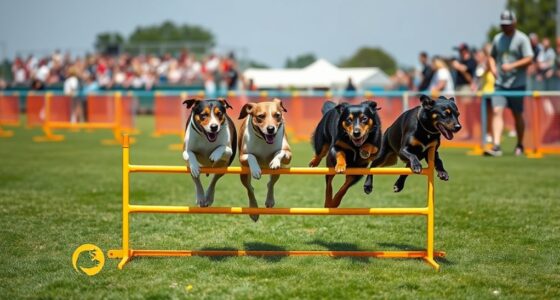To train protection dogs for guarding and security, you’ll select breeds like German Shepherds or Rottweilers with natural protective traits. Focus on basic obedience, then advance to controlled guarding skills, socialization, and desensitization to various stimuli. Proper professional training, certification, and ongoing reinforcement are essential for reliability and safety. These steps guarantee your dog responds confidently in real-world situations. If you want to discover the key details behind effective protection dog training, keep exploring further.
Key Takeaways
- Proper obedience training, including commands like sit, stay, and come, is essential for reliable protection and control.
- Advanced training involves controlled threat scenarios, bite work, and situational awareness to prepare dogs for real security situations.
- Breed selection based on traits like confidence, alertness, and protectiveness ensures the dog’s effectiveness in guarding roles.
- Socialization and temperament evaluation help develop confidence and prevent overreactions in various environments.
- Ongoing reinforcement, certification, and exposure to diverse stimuli maintain the dog’s readiness and responsiveness for security tasks.
Understanding the Role of Protection Dogs
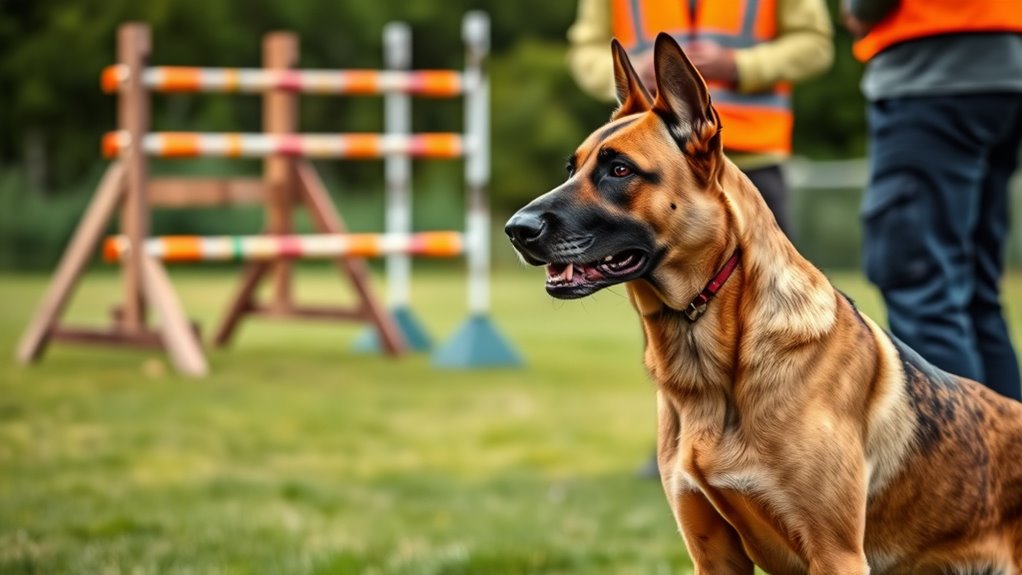
Protection dogs play a vital role in ensuring safety by acting as loyal and alert guardians. Many protection dog myths suggest they’re aggressive without reason, but their primary historical uses prove they’re highly trained for specific tasks. Throughout history, protection dogs have been employed to guard homes, livestock, and important figures, demonstrating their unwavering loyalty and intelligence. These animals aren’t instinctively aggressive; instead, they’re trained to respond appropriately to threats, providing a deterrent for potential intruders. Proper training methods contribute to their disciplined behavior and reliability as security partners. Additionally, their behavioral training ensures they remain calm and controlled in various situations. Their ability to sense danger and alert owners makes them essential for personal and property protection. Proper training also involves understanding dog psychology, which helps trainers develop more effective techniques. Moreover, understanding training techniques enhances a trainer’s ability to develop consistent and effective routines. Ultimately, protection dogs are more than just fierce-looking animals—they’re highly trained security partners.
Selecting the Right Breed for Security Purposes
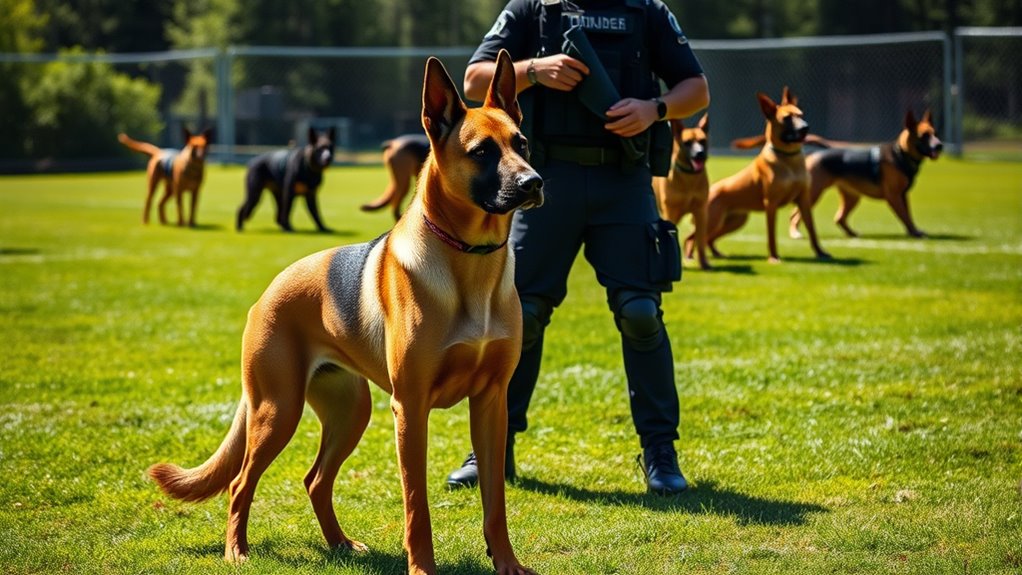
Choosing the right breed is essential when selecting a security dog, as different breeds have distinct temperament, strengths, and training needs. When considering breed characteristics, focus on traits like confidence, alertness, and loyalty, which are crucial for effective guarding. Your selection criteria should include size, energy level, trainability, and natural protective instincts. For example, breeds like German Shepherds and Rottweilers are known for their intelligence and protective nature, making them ideal for security work. On the other hand, smaller breeds may lack the physical presence needed for perimeter security. Ultimately, matching a breed’s characteristics with your specific security requirements ensures a better fit and more reliable protection. Carefully evaluate each breed’s traits before making your decision.
Basic Obedience Training Fundamentals
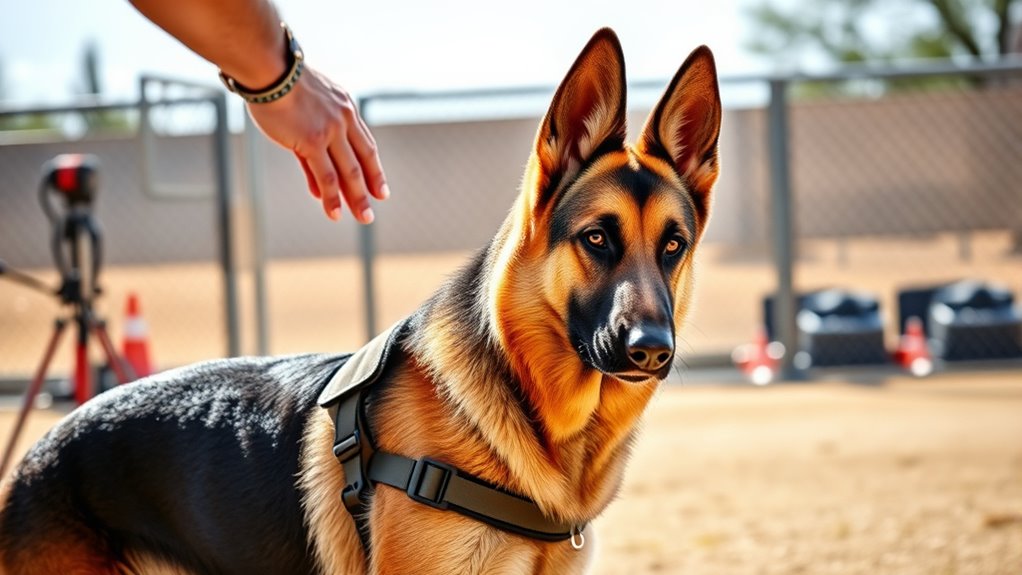
Starting your security dog’s training with basic obedience is essential for establishing control and ensuring effective communication. Use appropriate training equipment like collars and leashes to reinforce commands consistently. Implement reward systems such as treats or praise to motivate your dog and build a positive learning environment. Focus on foundational commands like sit, stay, come, and heel, which are vital for safety and control. Keep training sessions short and frequent to maintain your dog’s focus. Be patient and consistent, ensuring your dog understands each command before moving on. Remember, clear communication through training equipment and reinforcement helps your dog respond reliably in real-world security situations. Incorporating positive reinforcement techniques can significantly enhance the learning process. Consistent training methods are crucial for developing reliable response in various situations. Understanding the importance of training consistency can improve your dog’s performance and responsiveness over time. Additionally, incorporating diverse training scenarios can better prepare your dog for unpredictable environments and enhance their protective instincts. Regular exposure to different settings and distractions fosters behavioral adaptability, which is essential for effective guarding. Mastering these basics lays the groundwork for more advanced protection skills.
Advanced Protection Skills Development
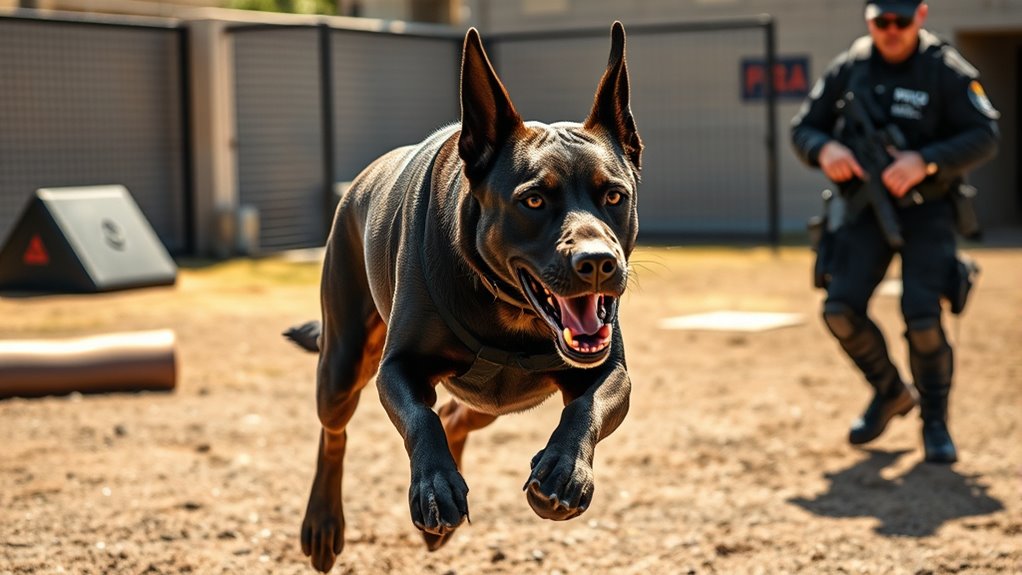
Building on the foundation of basic obedience, you can begin to develop your dog’s advanced protection skills by introducing controlled scenarios that simulate real threats. Focus on refining your dog’s threat assessment, teaching them to distinguish between harmless situations and genuine danger. Use progressive exercises to challenge their judgment and response times. Incorporate scenarios like controlled ambushes or intrusion alerts, ensuring your dog remains calm yet alert. Consistent training helps your dog develop the confidence to act decisively in high-stakes situations. Here’s a quick guide:
| Skill Focus | Training Approach |
|---|---|
| Threat assessment | Teach your dog to evaluate and respond appropriately through situational awareness training |
| Controlled aggression | Practice controlled biting and hold commands |
| Response timing | Use exercises to improve reaction speed |
| Situational awareness | Simulate real-world threats to sharpen alertness |
Additionally, using Pimple Patches as a metaphor for targeted and focused training can enhance your approach to developing these skills effectively. Proper training also benefits from understanding how trustworthiness of Patchology emphasizes quality and transparency, which can parallel the importance of building your dog’s reliability and confidence. Recognizing the importance of training consistency ensures your dog remains attentive and responsive in various scenarios.
Socialization and Desensitization Processes
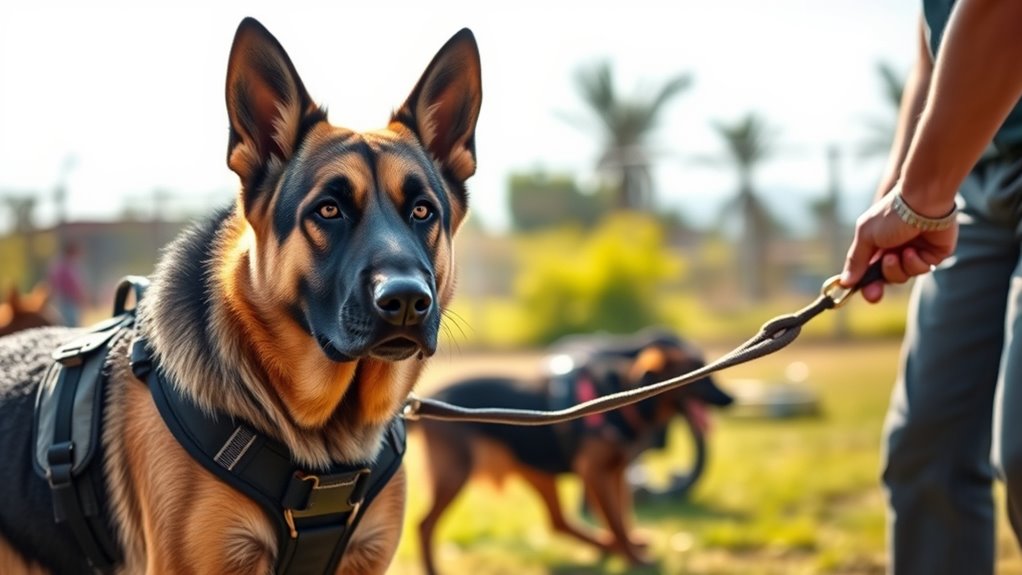
To guarantee your protection dog responds appropriately in any situation, effective socialization and desensitization are essential components of training. Socialization exposes your dog to various environments, people, and sounds, helping them stay calm and confident. Desensitization reduces overreactions to stimuli, like sudden noises or unfamiliar sights. Focus on these key areas:
- Introducing your dog to different environments, including busy playgrounds, ensuring playground safety. Incorporating controlled exposure to stimuli management can help prevent overreactive behaviors.
- Practicing leash compliance during walks to reinforce control in diverse settings.
- Gradually exposing your dog to new people and animals, promoting calm behavior.
- Reinforcing positive experiences to build trust and reduce anxiety.
- Implementing training strategies that consider state tax implications, ensuring your training investments are financially optimized. Additionally, understanding the influence of digital distractions can help tailor socialization practices for better focus and responsiveness.
- Staying informed about cybersecurity threats that may target training equipment or digital training tools, safeguarding your investment.
Consistent training in these areas prepares your protection dog to handle real-world scenarios with composure and confidence.
Assessing a Dog’s Temperament and Suitability
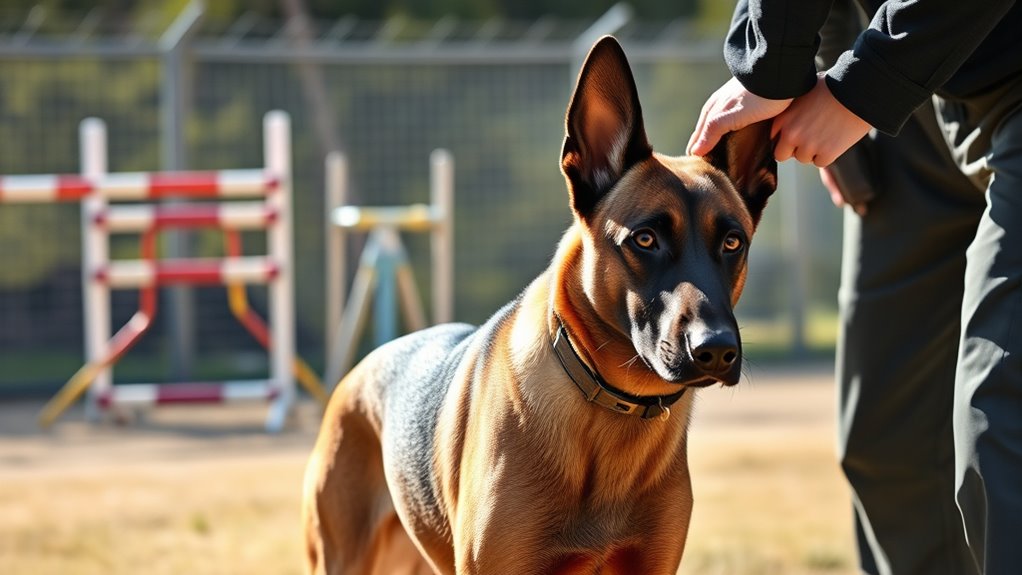
After successfully socializing and desensitizing your protection dog, the next step is to carefully assess its temperament and suitability for the demanding role. During a thorough temperament evaluation, observe how your dog responds to different stimuli and situations. Pay close attention to signs of dog aggression, ensuring it’s controlled and appropriate. A suitable protection dog should be confident, alert, and manageable, not overly fearful or aggressive without cause. Evaluate how your dog interacts with strangers, family members, and other animals. This assessment helps determine if your dog has the balanced temperament necessary for guarding work. Remember, understanding your dog’s natural tendencies allows you to make informed decisions about its training and future responsibilities. Incorporating mindful decluttering strategies into your training environment can help reduce chaos and improve focus during assessments. Additionally, assessing your dog’s performance metrics, such as confidence and reaction to stimuli, can provide valuable insights into its potential for guarding duties. Recognizing temperament traits aligned with protective behavior is essential to selecting the right candidate for security roles. Being aware of your dog’s spontaneous reactions can help identify natural guarding instincts that are crucial for security work.
Professional Training Programs and Certification
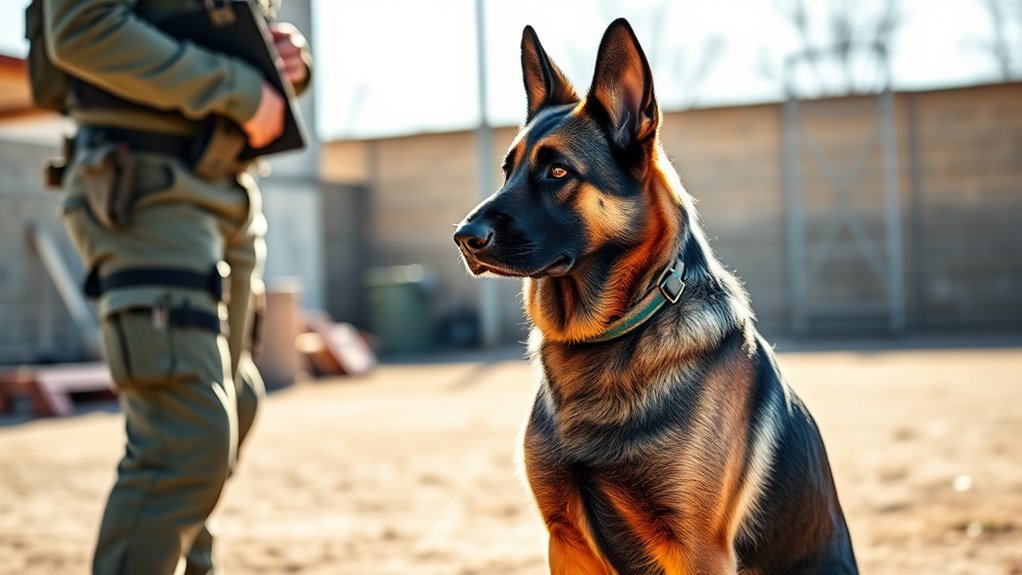
Enrolling your protection dog in a professional training program is essential to guarantee it develops the skills and discipline needed for the role. These programs focus on meeting strict Certification standards and ensuring Training safety throughout the process. When choosing a program, consider these key points:
- Verify the trainer’s credentials and experience in protection dog training.
- Ensure the curriculum covers obedience, control, and bite work.
- Confirm the facility adheres to safety protocols to prevent accidents.
- Look for programs that offer ongoing evaluations and certification upon completion.
- Incorporate Test Case Management concepts to monitor training progress and address areas needing improvement.
- Recognize the importance of How to Status procedures to ensure consistent training standards and progress tracking.
- Emphasize the significance of Emotional Support techniques in training to foster a well-rounded, confident protection dog.
- It is also beneficial to understand Training standards to maintain consistency across different programs and trainers.
A reputable program emphasizes consistency, safety, and adherence to industry standards. Proper training not only improves your dog’s effectiveness but also ensures it remains a safe, reliable protector in real-world situations.
Preparation for Real-World Security Scenarios
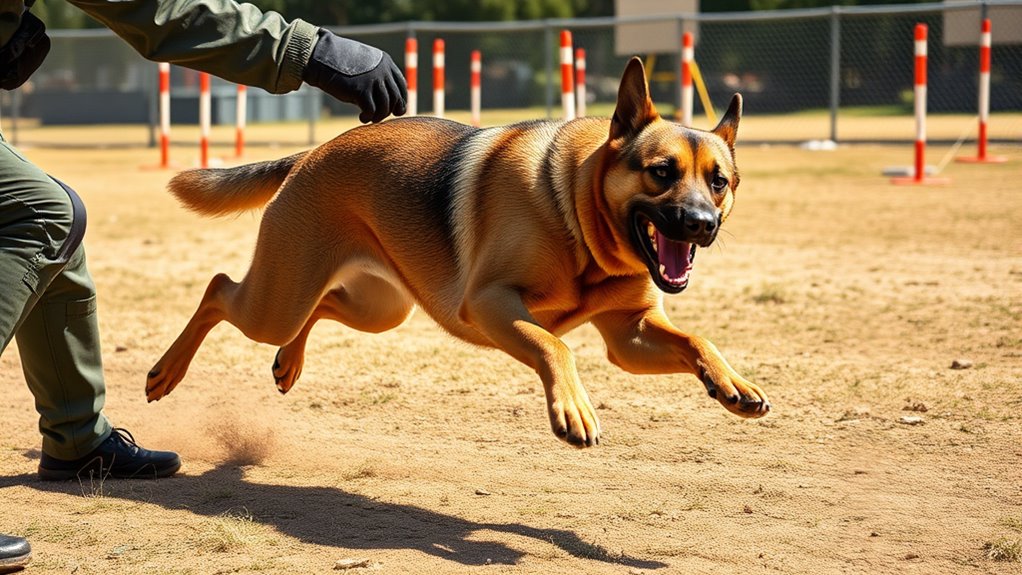
A well-trained protection dog must be prepared to handle unpredictable and dynamic real-world security situations. This requires thorough exposure to various environments, sounds, and stimuli. You should guarantee your dog’s diet supports their energy needs and overall health, enabling quick reactions when needed. Understanding the breed history helps you appreciate their instincts and natural guarding traits, which are essential in real scenarios. Imagine your dog facing a suspicious individual:
| Calm & Alert | Defensive & Controlled |
|---|---|
| Assess surroundings | Respond swiftly to threats |
| Maintain focus | Protect handler & property |
| Stay composed | Act decisively |
Preparation involves simulated threats, varied terrains, and distractions. This training sharpens your protection dog’s instincts, ensuring they’re ready for any situation.
Maintaining and Reinforcing Training Over Time
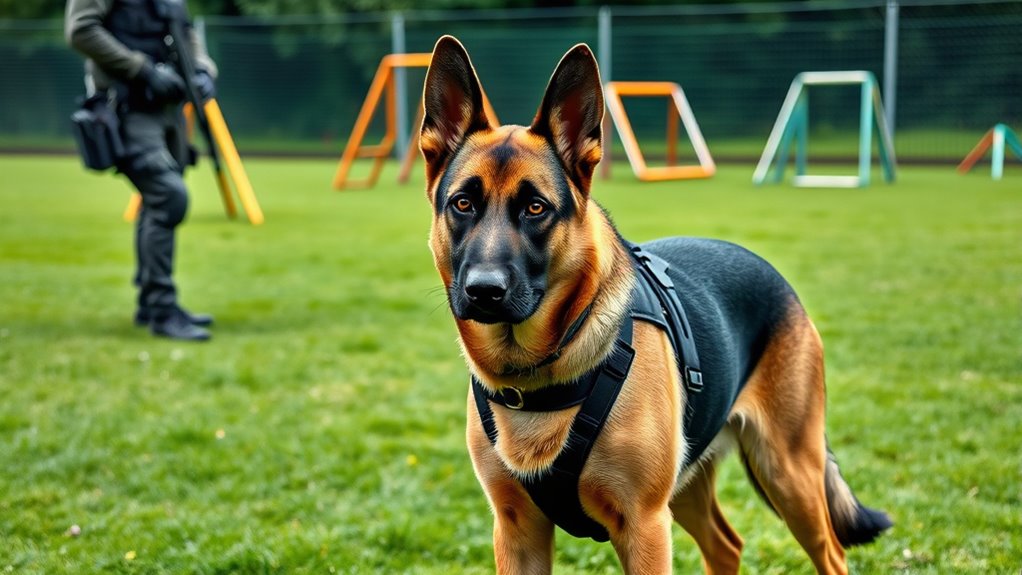
Maintaining and reinforcing your protection dog’s training is an ongoing process that demands consistent effort and attention. Regular practice ensures behavior reinforcement remains strong and reliable. To keep training effective, focus on:
Consistent training is essential to keep your protection dog reliable and confident.
- Consistent routines to build predictability.
- Reinforcing commands daily to strengthen behavior reinforcement.
- Varying training scenarios to maintain alertness and adaptability.
- Addressing any signs of regression immediately to prevent bad habits.
This approach helps your dog retain essential skills and stay confident in their role. Training consistency is key; it prevents confusion and solidifies responses under different circumstances. Remember, ongoing reinforcement isn’t just about maintaining control—it’s about ensuring your protection dog remains effective and dependable over time. Proper, regular training sustains their readiness and your peace of mind.
Frequently Asked Questions
How Long Does It Typically Take to Train a Protection Dog?
Training duration varies depending on your dog’s age, breed, and prior experience, but generally, it takes several months to develop the necessary skills. You’ll notice steady progress as your dog advances through basic obedience, bite work, and controlled guarding techniques. Consistent practice and proper socialization are key. Typically, expect a dedicated training period of 4 to 6 months to ensure your dog is confident, reliable, and well-prepared for protection tasks.
What Legal Considerations Are Involved in Owning a Protection Dog?
When owning a protection dog, you need to consider legal compliance and liability insurance. You must follow local laws about registration, licensing, and breed restrictions. Ensuring proper training and socialization helps prevent legal issues. Liability insurance is essential to protect yourself if the dog causes harm or damage. Staying informed about regulations and maintaining your dog’s training and behavior will keep you legally protected and compliant with the law.
Can Protection Dogs Be Trained for Family Protection Exclusively?
Think of a protection dog as a shield for your family. You can train them specifically for family safety, focusing on their temperament to make certain they’re calm around loved ones. These dogs can be conditioned to protect only when needed, making them loyal guardians without unnecessary aggression. With proper training, your protection dog becomes a trusted family member, providing security and peace of mind while respecting your household’s dynamic.
How Do You Handle a Protection Dog’s Aggressive Behavior?
When handling a protection dog’s aggressive behavior, you focus on aggression management and behavior modification. You should work closely with a professional trainer to identify triggers and develop a tailored training plan. Consistent commands, socialization, and positive reinforcement help reduce unwanted aggression. Remember, patience and ongoing training are key to ensuring your dog remains controlled and reliable in protecting you without unnecessary aggression.
What Are the Costs Associated With Professional Protection Dog Training?
The cost breakdown for professional protection dog training varies based on factors like dog age, breed, and training level. You should consider the training investment, which includes initial assessments, ongoing sessions, and specialized techniques. Typically, you might spend from $2,000 to $10,000 or more. Remember, quality training guarantees your dog’s effectiveness and safety, making it a worthwhile investment for your peace of mind and security.
Conclusion
Think of protection dogs as your loyal shield, ready to defend when needed but always under your control. Just like a well-tuned instrument, ongoing training and socialization keep their skills sharp. I once met a protection dog who, after months of proper training, calmly alerted his owner to a stranger—proving that with the right preparation, your dog becomes both a trusted partner and a fierce protector. Stay committed, and you’ll build a bond that’s both powerful and secure.






